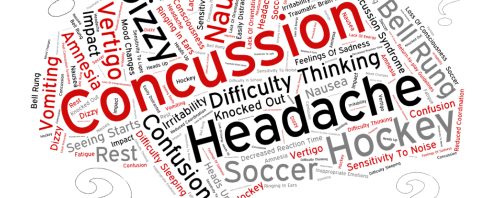Brain Injuries
Concussions are considered to be TBIs (traumatic brain injuries). Most concussions are mild, but they can scale up to severe depending on the intensity and symptoms of the injury. The impact of the brain on the skull causes membranes and axons to get stretchy, leading to a disruption of ion movement. This imbalance of ions, known as the energy crisis takes 7-10 days to return to normal, at which point it is typically considered safe to return to play for athletes. The increased ion flux also leads to migraines, often a symptom of concussion.

Energy Crisis
- This is the increased risk of subsequent concussions due to ion imbalance
- First 10 days post-injury are the greatest risk for permanent brain injury and subsequent concussions
- If subsequent mTBIs occur before full metabolic recovery, more severe hypometabolism and memory impairment
- Reduced glucose metabolism causes the increased risk
Concussion Horror Story: Chronic Traumatic Encephalopathy
Chronic Traumatic Encephalopathy is a degenerative brain disease that is most commonly found in athletes, veterans, and others with a history of brain trauma. CTE has gained attention due to the increasing publicity of NFL players suffering from this disease and its symptoms. Symptoms include: memory loss, confusion, impaired judgment, impulse control problems, aggression, depression, and paranoia. Cognitive symptoms tend to appear later than mood and behavioral symptoms, usually in the patient’s 40s or 50s.
In CTE, tau forms clumps due to impaired protein degradation mechanisms. These clumps spread throughout the brain, causing neuronal cell death. Hundreds to thousands of hits to the head cause this tau accumulation over time, with the best evidence pointing towards sub-concussive impacts rather than full-blown concussions. There are also several risk factors that make a person more susceptible to developing CTE, such as age of first exposure to head impacts and length of exposure to head impacts.
Diagnosing a Concussion
Immediate Post-Concussion Assessment and Cognitive Testing (ImPACT) is an online neurocognitive assessment with two components: a baseline test and post-injury testing. These are used together to assist in determining whether it is safe for a patient to return to an activity. This test measures key aspects of cognitive functioning such as memory, speed, and spatial span. The post-injury testing is used to help health care providers determine if it is safe to return to play.
The SCAT test is another diagnostic tool for concussions. It is very similar to the ImPACT test, although it is not administered online.
Safety Measures and Recovery
- Avoid too much cognitive stimulation
- Avoid contact activities that have a chance of receiving another concussive impact
- Do not take pain relievers, as these will mask symptoms, making health assessments inaccurate
- Be honest about symptoms, your brain is more important than playing in your next practice/game/match/contest
- Rest your brain and body
- Avoid driving too soon, your reaction time will be slower than usual


